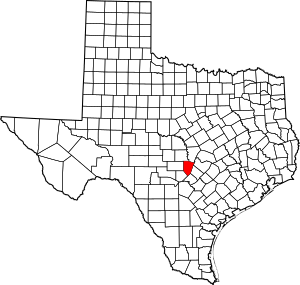Blanco County, Texas facts for kids
Quick facts for kids
Blanco County
|
|
|---|---|

The Blanco County Courthouse of 1916 was the first permanent courthouse built after the county seat moved to Johnson City in 1890.
|
|

Location within the U.S. state of Texas
|
|
 Texas's location within the U.S. |
|
| Country | |
| State | |
| Founded | February 12, 1858 |
| Named for | Blanco River |
| Seat | Johnson City |
| Largest city | Blanco |
| Area | |
| • Total | 713 sq mi (1,850 km2) |
| • Land | 709 sq mi (1,840 km2) |
| • Water | 4.2 sq mi (11 km2) 0.6% |
| Population
(2020)
|
|
| • Total | 11,374 |
| • Density | 15.952/sq mi (6.159/km2) |
| Time zone | UTC−6 (Central) |
| • Summer (DST) | UTC−5 (CDT) |
| Congressional district | 21st |
Blanco County is a county in the middle of Texas, USA. Its name comes from the Blanco River, which flows through the area. "Blanco" means "white" in Spanish. The main town, or county seat, is Johnson City.
In 2020, about 11,374 people lived in Blanco County. It's known for its beautiful Hill Country scenery.
Contents
History of Blanco County
Early Days and Founding
Long ago, around 1150 AD, Native American groups lived in the Blanco County area. Some of these might have been ancestors of the Lipan Apache. In 1721, a Spanish explorer named José de Azlor y Virto de Vera named the Blanco River.
In 1850, the Johnson family, including Samuel Ealy Johnson, Sr., who was the grandfather of future President Lyndon B. Johnson, started a cattle business in what is now Johnson City. The town was later named after their nephew.
Blanco County was officially created on February 12, 1858. It was formed from parts of other counties like Comal and Hays. The first county seat was the town of Blanco.
Growth and Changes
By 1860, about 1,218 people lived in Blanco County. Most settlers were from states like Tennessee and Alabama. They mainly farmed and raised livestock.
During the American Civil War, in 1861, Blanco County voted against leaving the Union. This showed their strong feelings about staying part of the United States.
In 1890, Johnson City became the new county seat. This was an important change for the county.
Farming and Famous Residents
In the early 1900s, farming became very important. Farmers grew crops like cotton, peanuts, and peaches. By 1929, the county was harvesting over 20,000 peach and pecan trees!
A very famous person from Blanco County is Lyndon B. Johnson. He later became the Vice President of the United States and then the President of the United States. His family moved to Johnson City in 1915. In 1937, he started his first campaign for Congress right from his family's home there.
LBJ was a big supporter of bringing electricity to rural areas. Thanks to his efforts, the first light bulb was turned on in rural Blanco County in 1938.
Parks and Tourism
In the 1930s, programs like the Civilian Conservation Corps helped improve parks and roads in the county. Blanco State Park opened in 1934.
When Lyndon B. Johnson became President in the 1960s, tourism grew in Blanco County. People wanted to visit the home of the President. Pedernales Falls State Park also opened to the public in 1970, offering beautiful natural sights.
Population Over Time
Blanco County has seen its population grow quite a bit over the years. Here's how the number of people living there has changed:
| Historical population | |||
|---|---|---|---|
| Census | Pop. | %± | |
| 1860 | 1,281 | — | |
| 1870 | 1,187 | −7.3% | |
| 1880 | 3,583 | 201.9% | |
| 1890 | 4,649 | 29.8% | |
| 1900 | 4,703 | 1.2% | |
| 1910 | 4,311 | −8.3% | |
| 1920 | 4,063 | −5.8% | |
| 1930 | 3,842 | −5.4% | |
| 1940 | 4,264 | 11.0% | |
| 1950 | 3,780 | −11.4% | |
| 1960 | 3,657 | −3.3% | |
| 1970 | 3,567 | −2.5% | |
| 1980 | 4,681 | 31.2% | |
| 1990 | 5,972 | 27.6% | |
| 2000 | 8,418 | 41.0% | |
| 2010 | 10,497 | 24.7% | |
| 2020 | 11,374 | 8.4% | |
| U.S. Decennial Census 1850–2010 2010 2020 |
|||
Geography
Blanco County is located in the Hill Country of central Texas. It's west of Austin and north of San Antonio. The county covers about 713 square miles, with most of it being land.
Two important rivers, the Blanco and the Pedernales, flow through the county. These rivers are a big part of the local landscape.
Main Roads
Neighboring Counties
Blanco County shares borders with several other counties:
- Burnet County (north)
- Travis County (northeast)
- Hays County (east)
- Comal County (southeast)
- Kendall County (southwest)
- Gillespie County (west)
- Llano County (northwest)
Parks and Protected Areas
- Lyndon B. Johnson National Historical Park (part of it is in Blanco County)
- Pedernales Falls State Park
Communities
Cities
- Blanco
- Johnson City (the county seat)
Town
Other Communities
These are smaller communities that are not officially cities or towns:
- Blowout
- Cypress Mill
- Flugrath
- Hye
- Peyton
- Post Oak
- Rocky Creek
- Sandy
- Twin Sisters
Education
Students in Blanco County attend schools in these districts:
- Blanco Independent School District
- Fredericksburg Independent School District
- Johnson City Independent School District
For college, Austin Community College is the main community college for the county.
See also
 In Spanish: Condado de Blanco para niños
In Spanish: Condado de Blanco para niños

